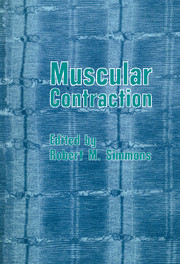Book contents
- Frontmatter
- Contents
- Dedication
- Contributors
- Preface
- 1 A. F. Huxley: an essay on his personality and his work on nerve physiology
- 2 A. F. Huxley's research on muscle
- 3 Ultraslow, slow, intermediate, and fast inactivation of human sodium channels
- 4 The structure of the triad: local stimulation experiments then and now
- 5 The calcium-induced calcium release mechanism in skeletal muscle and its modification by drugs
- 6 Hypodynamic tension changes in the frog heart
- 7 Regulation of contractile proteins in heart muscle
- 8 Differential activation of myofibrils during fatigue in twitch skeletal muscle fibres of the frog
- 9 High-speed digital imaging microscopy of isolated muscle cells
- 10 Inotropic mechanism of myocardium
- 11 Regulation of muscle contraction: dual role of calcium and cross-bridges.
- 12 Fibre types in Xenopus muscle and their functional properties.
- 13 An electron microscopist's role in experiments on isolated muscle fibres.
- 14 Structural changes accompanying mechanical events in muscle contraction.
- 15 Mechano-chemistry of negatively strained cross-bridges in skeletal muscle.
- 16 Force response in steady lengthening of active single muscle fibres.
- References
- Index
5 - The calcium-induced calcium release mechanism in skeletal muscle and its modification by drugs
Published online by Cambridge University Press: 07 September 2010
- Frontmatter
- Contents
- Dedication
- Contributors
- Preface
- 1 A. F. Huxley: an essay on his personality and his work on nerve physiology
- 2 A. F. Huxley's research on muscle
- 3 Ultraslow, slow, intermediate, and fast inactivation of human sodium channels
- 4 The structure of the triad: local stimulation experiments then and now
- 5 The calcium-induced calcium release mechanism in skeletal muscle and its modification by drugs
- 6 Hypodynamic tension changes in the frog heart
- 7 Regulation of contractile proteins in heart muscle
- 8 Differential activation of myofibrils during fatigue in twitch skeletal muscle fibres of the frog
- 9 High-speed digital imaging microscopy of isolated muscle cells
- 10 Inotropic mechanism of myocardium
- 11 Regulation of muscle contraction: dual role of calcium and cross-bridges.
- 12 Fibre types in Xenopus muscle and their functional properties.
- 13 An electron microscopist's role in experiments on isolated muscle fibres.
- 14 Structural changes accompanying mechanical events in muscle contraction.
- 15 Mechano-chemistry of negatively strained cross-bridges in skeletal muscle.
- 16 Force response in steady lengthening of active single muscle fibres.
- References
- Index
Summary
Introduction
I joined Andrew Huxley's laboratory in the autumn of 1962, coming from H. Kumagai's laboratory in Tokyo. Contact had been made by Setsuro Ebashi, one of the senior students of H. Kumagai, who visited Andrew Huxley for the first time in 1960 on his return to Tokyo from Rockefeller University, where he had just established the essential part of his calcium theory, and from whom I had learnt muscle biochemistry and physiology. Initially, Prof and I had almost decided to start examining the influence of extracellular calcium on depolarisation-contraction coupling, but during my initial training in preparing single muscle fibres H. C. Lüttgau visited us on his way to Cambridge and disclosed that he had already done almost everything I intended to do. Then Prof suggested an alternative project – to examine whether the lumen of the Ttubule is continuous with the extracellular space by the use of fluorescent dyes, to which I devoted the entire one year and eight months of my stay in London. After coming back to Tokyo, I intended to proceed to the next step – to T-tubule depolarisation (i.e., the mechanism of calcium release from the sarcoplasmic reticulum). Although I have not yet been able to elucidate the physiological mechanism of calcium release, I have investigated problems related to the mechanism, as is described in this chapter.
Of course, I learnt very much from Prof in London, but I also received a great deal from him after I came back to Tokyo.
- Type
- Chapter
- Information
- Muscular Contraction , pp. 67 - 82Publisher: Cambridge University PressPrint publication year: 1992
- 4
- Cited by



